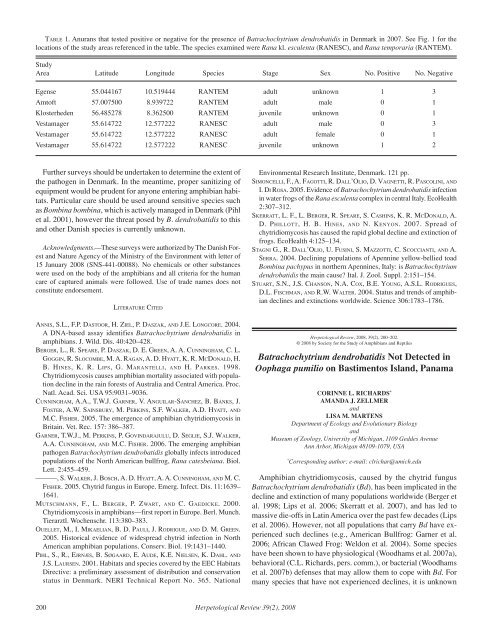Herpetological Review Herpetological Review - Doczine
Herpetological Review Herpetological Review - Doczine
Herpetological Review Herpetological Review - Doczine
Create successful ePaper yourself
Turn your PDF publications into a flip-book with our unique Google optimized e-Paper software.
TABLE 1. Anurans that tested positive or negative for the presence of Batrachochytrium dendrobatidis in Denmark in 2007. See Fig. 1 for thelocations of the study areas referenced in the table. The species examined were Rana kl. esculenta (RANESC), and Rana temporaria (RANTEM).StudyArea Latitude Longitude Species Stage Sex No. Positive No. NegativeEgense 55.044167 10.519444 RANTEM adult unknown 1 3Amtoft 57.007500 8.939722 RANTEM adult male 0 1Klosterheden 56.485278 8.362500 RANTEM juvenile unknown 0 1Vestamager 55.614722 12.577222 RANESC adult male 0 3Vestamager 55.614722 12.577222 RANESC adult female 0 1Vestamager 55.614722 12.577222 RANESC juvenile unknown 1 2Further surveys should be undertaken to determine the extent ofthe pathogen in Denmark. In the meantime, proper sanitizing ofequipment would be prudent for anyone entering amphibian habitats.Particular care should be used around sensitive species suchas Bombina bombina, which is actively managed in Denmark (Pihlet al. 2001), however the threat posed by B. dendrobatidis to thisand other Danish species is currently unknown.Acknowledgments.—These surveys were authorized by The Danish Forestand Nature Agency of the Ministry of the Environment with letter of15 January 2008 (SNS-441-00088). No chemicals or other substanceswere used on the body of the amphibians and all criteria for the humancare of captured animals were followed. Use of trade names does notconstitute endorsement.LITERATURE CITEDANNIS, S.L., F.P. DASTOOR, H. ZIEL, P. DASZAK, AND J.E. LONGCORE. 2004.A DNA-based assay identifies Batrachochytrium dendrobatidis inamphibians. J. Wild. Dis. 40:420–428.BERGER, L., R. SPEARE, P. DASZAK, D. E. GREEN, A. A. CUNNINGHAM, C. L.GOGGIN, R. SLOCOMBE, M. A. RAGAN, A. D. HYATT, K. R. MCDONALD, H.B. HINES, K. R. LIPS, G. MARANTELLI, AND H. PARKES. 1998.Chytridiomycosis causes amphibian mortality associated with populationdecline in the rain forests of Australia and Central America. Proc.Natl. Acad. Sci. USA 95:9031–9036.CUNNINGHAM, A.A., T.W.J. GARNER, V. ANGUILAR-SANCHEZ, B. BANKS, J.FOSTER, A.W. SAINSBURY, M. PERKINS, S.F. WALKER, A.D. HYATT, ANDM.C. FISHER. 2005. The emergence of amphibian chytridiomycosis inBritain. Vet. Rec. 157: 386–387.GARNER, T.W.J., M. PERKINS, P. GOVINDARAJULU, D. SEGLIE, S.J. WALKER,A.A. CUNNINGHAM, AND M.C. FISHER. 2006. The emerging amphibianpathogen Batrachochytrium dendrobatidis globally infects introducedpopulations of the North American bullfrog, Rana catesbeiana. Biol.Lett. 2:455–459.––––––, S. WALKER, J. BOSCH, A. D. HYATT, A. A. CUNNINGHAM, AND M. C.FISHER. 2005. Chytrid fungus in Europe. Emerg. Infect. Dis. 11:1639–1641.MUTSCHMANN, F., L. BERGER, P. ZWART, AND C. GAEDICKE. 2000.Chytridiomycosis in amphibians—first report in Europe. Berl. Munch.Tierarztl. Wochenschr. 113:380–383.OUELLET, M., I. MIKAELIAN, B. D. PAULI, J. RODRIGUE, AND D. M. GREEN.2005. Historical evidence of widespread chytrid infection in NorthAmerican amphibian populations. Conserv. Biol. 19:1431–1440.PIHL, S., R., EJRNÆS, B. SØGAARD, E. AUDE, K.E. NIELSEN, K. DAHL. ANDJ.S. LAURSEN. 2001. Habitats and species covered by the EEC HabitatsDirective: a preliminary assessment of distribution and conservationstatus in Denmark. NERI Technical Report No. 365. NationalEnvironmental Research Institute, Denmark. 121 pp.SIMONCELLI, F., A. FAGOTTI, R. DALL’OLIO, D. VAGNETTI, R. PASCOLINI, ANDI. DI ROSA. 2005. Evidence of Batrachochytrium dendrobatidis infectionin water frogs of the Rana esculenta complex in central Italy. EcoHealth2:307–312.SKERRATT, L. F., L. BERGER, R. SPEARE, S. CASHINS, K. R. MCDONALD, A.D. PHILLOTT, H. B. HINES, AND N. KENYON. 2007. Spread ofchytridiomycosis has caused the rapid global decline and extinction offrogs. EcoHealth 4:125–134.STAGNI G., R. DALL’OLIO, U. FUSINI, S. MAZZOTTI, C. SCOCCIANTI, AND A.SERRA. 2004. Declining populations of Apennine yellow-bellied toadBombina pachypus in northern Apennines, Italy: is Batrachochytriumdendrobatidis the main cause? Ital. J. Zool. Suppl. 2:151–154.STUART, S.N., J.S. CHANSON, N.A. COX, B.E. YOUNG, A.S.L. RODRIGUES,D.L. FISCHMAN, AND R.W. WALTER. 2004. Status and trends of amphibiandeclines and extinctions worldwide. Science 306:1783–1786.<strong>Herpetological</strong> <strong>Review</strong>, 2008, 39(2), 200–202.© 2008 by Society for the Study of Amphibians and ReptilesBatrachochytrium dendrobatidis Not Detected inOophaga pumilio on Bastimentos Island, PanamaCORINNE L. RICHARDS *AMANDA J. ZELLMERandLISA M. MARTENSDepartment of Ecology and Evolutionary BiologyandMuseum of Zoology, University of Michigan, 1109 Geddes AvenueAnn Arbor, Michigan 48109-1079, USA*Corresponding author; e-mail: clrichar@umich.eduAmphibian chytridiomycosis, caused by the chytrid fungusBatrachochytrium dendrobatidis (Bd), has been implicated in thedecline and extinction of many populations worldwide (Berger etal. 1998; Lips et al. 2006; Skerratt et al. 2007), and has led tomassive die-offs in Latin America over the past few decades (Lipset al. 2006). However, not all populations that carry Bd have experiencedsuch declines (e.g., American Bullfrog: Garner et al.2006; African Clawed Frog: Weldon et al. 2004). Some specieshave been shown to have physiological (Woodhams et al. 2007a),behavioral (C.L. Richards, pers. comm.), or bacterial (Woodhamset al. 2007b) defenses that may allow them to cope with Bd. Formany species that have not experienced declines, it is unknown200 <strong>Herpetological</strong> <strong>Review</strong> 39(2), 2008














